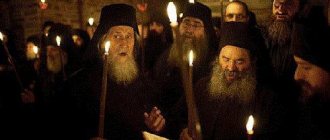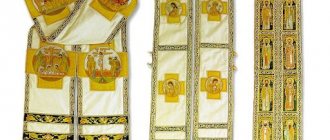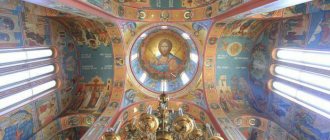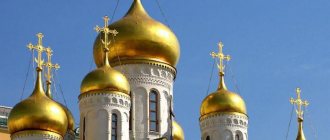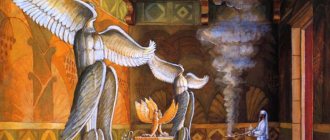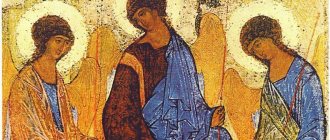Patriarch
(Greek πατριάρχηζ - “ancestor”) - the title of the head of the local Church in some Orthodox Churches.
The Patriarch is elected by the local council. The title was established by the Fourth Ecumenical Council of Chalcedon in 451.
In Rus', the patriarchate was established in 1589; in 1721 - abolished and replaced by a collegial body - the Synod; in 1918 - restored.
Currently, the following Orthodox patriarchates exist: Constantinople, Alexandria, Antioch, Jerusalem, Moscow, Georgian, Serbian, Romanian and Bulgarian.
History of the concept
The name “patriarch” in relation to bishops has been used since the end of the 4th century. How The first official church document in which the word “patriarch” is used to designate the highest hierarch was the Constitution of Emperor Zeno (477). It is argued that in canonical sources this title was noted even later, for example, in the 7th rule of the Council of Trullo.
By the 6th century, the concept of “pentarchy” was emerging - before the schism of the Christian Churches in 1054, this title was attributed to five bishops of the ancient Greco-Roman metropolises: Rome, Constantinople, Alexandria, Antioch, and Jerusalem. Mention of the pentarchy is also found in the Russian “Helmsman’s Book” in the 40th chapter, although for the 13th century, when this version of the Helmsman was written, the concept of the pentarchy was already outdated.
After the schism of 1054, the title "patriarch" was assigned to the primates of the Eastern Orthodox Local Churches, and then to all primates of the Orthodox autocephalous churches. So, for example, under Tsar Simeon in 919, the Bulgarians declared autocephaly at the Council in Preslavl; the Preslav Council also elevated Bulgarian autocephaly to the rank of a patriarchate, with a ruling bishop-patriarch.
Patriarchal dignity is not a separate degree of priesthood. In relation to the remaining bishops, the “patriarch” acts as the first bishop, the first hierarch, but equal in degree of priesthood.
History of the Patriarchate in the Russian Orthodox Church
The patriarchate in Russia dates back to the 16th century, when the patriarchal dignity was awarded to Metropolitan Job of Moscow by the Ecumenical (Constantinople) Patriarch Jeremiah II in 1589 . In 1590, Metropolitan Dionysius of Tarnovo arrived in Moscow and brought from Constantinople a Cathedral Charter, which recognized Metropolitan Job as patriarch and assigned Moscow 5th place in the diptych of Local Orthodox Churches. After the Council of Eastern Hierarchs in Constantinople on February 12, 1593, Moscow’s 5th place was once again confirmed and enshrined in a conciliar act and, ultimately, accepted by the Moscow government led by Boris Godunov.
After the death of Patriarch Adrian in 1700, Tsar Peter I the Great abolished the patriarchate and in 1721 established the Theological College, which would soon become the Holy Governing Synod, the highest body of church government in the Russian Empire.
The patriarchate was restored at the All-Russian Local Council of 1917–1918, and Metropolitan Tikhon (Bellavin) of Moscow became the first elected patriarch.
In total, there were 15 patriarchs in Russia, and the 16th carries out his ministry in our time:
- Job (1589–1605);
- Hermogenes (1606–1612);
- Filaret (1619–1633);
- Joasaph I (1634–1640);
- Joseph (1642–1652);
- Nikon (1652–1666);
- Joasaph II (1667–1672);
- Pitirim (1672–1673);
- Joachim (1674–1690);
- Adrian (1690–1700);
- Tikhon (1917–1925);
- Sergius (1943–1944);
- Alexy I (1945–1970);
- Pimen (1971–1990);
- Alexy II (1990–2008);
- Kirill (elected 2009)
History of the patriarchate in Rus'. Reference
In 1721 the Patriarchate was abolished. In 1721, Peter I established the Theological College, which was later renamed the Holy Governing Synod - the state body of the highest ecclesiastical authority in the Russian Church. The patriarchate was restored by the decision of the All-Russian Local Council on October 28 (November 11), 1917.
The title “His Holiness Patriarch of Moscow and All Rus'” was adopted in 1943 by Patriarch Sergius at the suggestion of Joseph Stalin. Until this time, the Patriarch bore the title “Moscow and All Russia”. The replacement of Russia with Rus in the title of Patriarch is due to the fact that with the emergence of the USSR, Russia officially meant only the RSFSR, while the jurisdiction of the Moscow Patriarchate extended to the territory of other republics of the Union.
According to the Statute of the Russian Orthodox Church, adopted in 2000, His Holiness the Patriarch of Moscow and All Rus' “has primacy of honor among the episcopate of the Russian Orthodox Church and is accountable to the Local and Bishops’ Councils... has care for the internal and external welfare of the Russian Orthodox Church and governs it together with the Holy Synod , being its Chairman." The Patriarch convenes Bishops' and Local Councils and presides over them, and is also responsible for the implementation of their decisions. The Patriarch represents the Church in external relations, both with other Churches and with secular authorities. His responsibilities include maintaining the unity of the hierarchy of the Russian Orthodox Church, issuing (together with the Synod) decrees on the election and appointment of diocesan bishops, and he exercises control over the activities of bishops.
According to the charter, “the external distinctive signs of patriarchal dignity are a white cap, a green mantle, two panagias, a great paraman and a cross.”
The Patriarch of Moscow and All Rus' is the diocesan bishop of the Moscow diocese, consisting of the city of Moscow and the Moscow region, the Holy Archimandrite of the Holy Trinity Sergius Lavra, governs the patriarchal metochions throughout the country, as well as the so-called stauropegial monasteries, subordinate not to local bishops, but directly to the Moscow Patriarchate.
In the Russian Church, this Patriarch is given for life, and this means that until his death the patriarch is obliged to serve the Church, even if he is seriously ill or is in exile or imprisonment.
Chronological list of Moscow Patriarchs
Saint Job (January 23, 1589 - June 1605)
Ignatius (June 30, 1605 - May 1606), installed False Dmitry I during the living Patriarch Job and therefore is not included in the lists of legitimate Patriarchs, although he was installed in compliance with all formalities
Hieromartyr Hermogenes (or Hermogenes) (June 3, 1606 - February 17, 1612), canonized in 1913.
Filaret (Fedor Nikitich Romanov) (June 24, 1619 - October 1, 1633)
Joasaph I (February 6, 1634 - November 28, 1640)
Joseph (May 27, 1642 - April 15, 1652)
Nikon (Nikita Minov) (July 25, 1652 - December 12, 1666)
Joasaph II (February 10, 1667 - February 17, 1672)
Pitirim (July 7, 1672 - April 19, 1673)
Joachim (Savelov) (July 26, 1674 - March 17, 1690)
Adrian (24 August 1690 - 16 October 1700)
After the death of Patriarch Hadrian, no successor was elected. In 1700-1721, the Guardian of the Patriarchal Throne (“Exarch”) was Metropolitan Stefan (Yavorsky) of Yaroslavl.
Moscow Patriarchs in 1917-2008
Saint Tikhon (Vasily Ivanovich Bellavin; November 5 (18), 1917 - March 25 (April 7), 1925)
Sergius (Ivan Nikolaevich Stragorodsky; September 8, 1943 - May 15, 1944)
Alexy I (Sergei Vladimirovich Simansky February 2, 1945 - April 17, 1970)
Pimen (Sergei Mikhailovich Izvekov; June 2, 1971 - May 3, 1990)
Alexy II (Alexey Mikhailovich Ridiger; June 10, 1990 - December 5, 2008).
The status of the patriarch in the modern Charter of the Russian Orthodox Church
According to the Statute of the Russian Orthodox Church (see separate Chapter IV of the Statute), the Primate of the Russian Orthodox Church bears the title: “His Holiness Patriarch of Moscow and All Rus'.” He has the “primacy of honor” among the episcopate and is accountable to the Local and Bishops' Councils. The name of the patriarch is exalted in all churches of the Russian Orthodox Church during divine services according to the following formula:
About the Great Lord and Our Father (name), His Holiness Patriarch of Moscow and All Rus'
The seventh paragraph of the Statute of the Russian Orthodox Church defines 31 duties that are the responsibility of His Holiness the Patriarch:
- Responsibility for the implementation of decisions of the Local, Bishops' Councils and the Holy Synod.
- Providing reports on the state of the Church to councils during the inter-council period.
- Maintaining the unity of the hierarchy of the Russian Church.
- Presidency and convening of the Supreme Church Council.
- Submission of candidates for membership of the Inter-Council Presence for approval by the Holy Synod.
- Supervisory supervision of the work of synodal institutions.
- Addressing pastoral messages to the entirety of the Russian Orthodox Church.
- Signing of church-wide documents with the approval of the Holy Synod.
- Exercising executive and administrative powers to manage the Moscow Patriarchate.
- Interchurch communication with the primates of other Local Churches.
- Implementation of the representation of the Russian Church before the highest bodies of state power and administration.
- Petition and grief before government authorities both in the canonical territory and beyond.
- Approval of the statutes of Self-Governing Churches, Exarchates, Metropolitan Districts, and Dioceses.
- Approval of the journals of the Synods of the Exarchates and Metropolitan Districts.
- Acceptance of appeals from diocesan bishops of Self-Governing Churches.
- Approval of decisions of the general church court in cases where they are provided for by the Regulations on the Church Court.
- Issuance of decrees on the election and appointment of diocesan bishops, heads of synodal institutions, vicar bishops, rectors of theological educational institutions, as well as other officials appointed by the Holy Synod, with the exception of rectors of theological educational institutions, as well as abbots (abbesses) and governors of monasteries of diocesan subordination.
- Care for the timely replacement of episcopal departments.
- Instructing bishops to temporarily administer dioceses in the event of long-term illness, death, or being under ecclesiastical court of diocesan bishops.
- Monitoring the fulfillment by bishops of their archpastoral duty to care for the dioceses.
- Visit, if necessary, to all (any) dioceses of the Russian Orthodox Church.
- Approval of annual reports of diocesan bishops.
- Teaching bishops fraternal advice both regarding their personal lives and regarding the performance of their archpastoral duty; in case of inattention to his advice - an appeal to the Holy Synod to make an appropriate decision.
- Consideration of cases related to misunderstandings between bishops who voluntarily turn to his mediation without formal legal proceedings; The decisions of the Patriarch in such cases are binding on both parties.
- Receiving complaints against bishops and giving them proper action.
- Allowing bishops to leave for periods of more than 14 days.
- Rewarding bishops with established titles and highest church honors.
- Rewarding clergy and laity with church awards.
- Approval of the creation of new departments in religious educational institutions (as recommended by the Educational Committee).
- Approval of the awarding of [church] academic degrees and titles.
- Care for the timely production and consecration of the holy world for general church needs.
According to the Statute of the Russian Orthodox Church, “The Patriarch of Moscow and All Rus' is the diocesan bishop of the Moscow diocese, consisting of the city of Moscow and the Moscow region.” “The Patriarch of Moscow and All Rus' is assisted in the management of the Moscow diocese by the Patriarchal Viceroy with the rights of a diocesan bishop with the title of Metropolitan of Krutitsky and Kolomna.” His Holiness the Patriarch is also the Holy Archimandrite of the Holy Trinity Sergius Lavra and a number of other monasteries, and governs all church stauropegies. The formation of stauropegial monasteries within the Moscow diocese is carried out by decrees of the patriarch, in other dioceses in agreement with the ruling bishops.
The charter states: “The dignity of Patriarch is for life.” The right to consider the issue of the patriarch’s retirement remains with the Local Council. The right to try the patriarch remains with the Council of Bishops. After the death, departure or removal of the patriarch, the Holy Synod immediately elects from among itself the Locum Tenens of the Patriarchal Throne. To elect a new patriarch, the Holy Synod is obliged to convene a Local Council.
The Patriarch has external distinctive signs in comparison with other bishops: a white kukol (headdress), a green mantle, two panagia (breast icons), a great paraman and a cross.
The following requirements are put forward for a candidate for patriarch:
- Availability of episcopal rank.
- Possession of a higher theological education, experience in diocesan administration, and commitment to canonical law and order.
- Having a good reputation, the trust of other hierarchs, clergy and people.
- Must “have a good testimony from outsiders” (1 Tim. 3:7);
- Age not younger than 40 years.
The meaning of the word patriarch
Examples of the use of the word patriarch in literature.
Silena sent with Ulfila a man from those who had been inseparably with the Gothic patriarch since the very time when Mercurinus Auxentius left the community.
To do this, it was enough to swap two ceremonies and become an autocephalous patriarch before the royal status of Danila Romanovich was legitimized by all honest people.
They pray for the Republic, the old are supposed to pray for Patriarch Tikhon, but this is not allowed under any circumstances, and it seems that they are not so much praying as quietly anathematizing, and, finally, I don’t know what the autocephalous people are praying for.
A prayer service is held, and the Patriarch is greeted by representatives of the autocephalous Churches - Willebrands, Blake and others.
As he gains more and more power, the authoritarian patriarch seeks to prevent weaker members of the community from establishing connections with other communities.
Protospatharius tried to suppress his indignation, but Agelast whispered to the patriarch standing next to him: “This northern halberd can not only chop, but also stab.”
And Alexy quietly but firmly asked to convey to the patriarch the urgent request of the embassy to bless them immediately after the liturgy.
Meanwhile, the boyars were busy trying to arrange a meeting between Alexy and Cantacuzinus, and Alexy himself tried in vain to have an unpublicized discussion with the patriarch.
But Amalrik, not at all embarrassed, bowed to his mother, brother, patriarch and began like this: “First of all, we need to find out on what the right to the royal throne in Jerusalem is based and to whom it belongs.”
In addition to the king and patriarch Fulcherius, who erected the sacred relic - the crossbar of the Lord's cross in a magnificent white tent of Chinese silk, there were the Archbishop of Tyre, Archbishop Baldwin of Caesarea, Archbishop Robert of Nazareth, as well as Bishops Frederick of Accona, Gerald of Bethlehem, Bernard of Sidon and Amalric, the abbot Monastery of Saint Abraham.
Your father, the great master, the most holy Cyrus Anikita, Archbishop of Preshpurg and all Yauza and all Kukui, Patriarch, and your servants generals Anton Mikhailovich and Franz Yakovlevich and their comrades are in good health, and now we are setting off from Panshin in good health.
Having turned the Empress Mother Anna of Savoy, Patriarch John and the Synclitians against Cantacuzenus, Apocaucus began to attack the regent, challenge his rights and secretly prepare a coup.
In addition, the Testaments of Levi, Naphtali and Joseph include visions of these patriarchs, which have a pronounced apocalyptic character.
The Patriarch, without going into details, refused to take part in the burial, insisting that DNA analysis is too new, a research that has not been tested in the world and is not recognized by law everywhere.
The frightened Patriarch Anastasius recognized Artavazd as emperor and praised his piety, welcoming the freedom of icon veneration.
Source: Maxim Moshkov library
His Holiness Patriarch of Moscow and All Rus' Kirill
The Primate of the Russian Orthodox Church since February 1, 2009 is His Holiness Patriarch Kirill of Moscow and All Rus' (in the world Vladimir Mikhailovich Gundyaev; born November 20, 1946, Leningrad, USSR); from 1995 to 2000, Metropolitan Kirill was the chairman of the Synodal working group on developing the concept of the Russian Orthodox Church on issues of church-state relations and problems of modern society, in particular, it was under his leadership that the document “Fundamentals of the social concept of the Russian Orthodox Church” was developed, adopted at the Council of Bishops in 2000, and on December 6, 2008 he was elected Patriarchal Locum Tenens. On January 27, 2009, Metropolitan Kirill was elected Patriarch of Moscow and All Rus' by the Local Council, and his enthronement took place on February 1, 2009.
Patriarch: first among fathers
Estimated reading time: less than a minute.
If an ordinary person is asked who the Patriarch is, he will very likely answer that the Patriarch is the head of the Church. Indeed, we often, for example, hear in the news about His Holiness Patriarch Kirill that “the head of the Russian Orthodox Church did this or that.”
However, such word usage cannot be considered flawless. Indeed, in the proper sense, the Head of the Church, which is the Body of Christ, is only the Savior himself. The Apostle Paul says that “the husband is the head of the wife, just as Christ is the head of the Church” (Eph 5:23). The Church was directly founded by God himself, and the only Head of the Universal Church is Jesus Christ.
However, in Orthodoxy, the Universal Church, in a certain sense, consists of Local Churches. Today, there are only fifteen of them, which are completely independent and self-governing, and eight of them are Patriarchates (i.e., they are headed by Patriarchs): Constantinople (Turkey), Alexandria (Egypt), Antioch (Syria), Jerusalem, Moscow, Georgian, Serbian, Romanian and Bulgarian.
In Orthodoxy, the patriarch is the supreme hierarch who administers the Local Church entrusted to him together with the Holy Synod. And the fact that he does not rule in his government like a sole monarch is expressed in the ancient Greek word ὁ πατριάρχης (patriarhēs). It is formed from the words ὁ πατήρ (patēr) - father, and ἡ αρχή (arhē) - power. The word “Patriarch” can be translated into Russian, firstly, as ancestor or forefather. And, secondly, this word can also be translated as “head of the fathers” or even as “first among the fathers,” since ἡ αρχή is not only power, but also the beginning.
The patriarch in Orthodoxy is not some kind of highest degree of priesthood. He is not the bearer of the highest sacred authority in the Local Church, to which She must unconditionally submit. It is rather an honorary title, which marks the first among bishops.
Thus, the Patriarch in the Orthodox Church cannot, like the Pope in the Catholic Church, be the final and decisive authority on any dogmatic and moral issues. The 1992 Catechism of the Catholic Church states in paragraph 882 that “The Roman Pontiff has over the Church, by virtue of his office as Vicar of Christ and Shepherd of the whole Church, full sovereign and universal power, which he has the right to freely exercise at all times.” And even the Ecumenical Council among Roman Catholics is considered such only if the pope convened it and approved its decisions.
At the same time, for example, in relation to the Patriarch of Moscow and All Rus', the Charter of our Church actually does not even use the word “head”. The Patriarch there is called the Primate of the Russian Orthodox Church, who “has primacy of honor among bishops and is accountable to the Local and Bishops’ Councils.” The highest bodies of church authority according to the Charter are the Local Council, the Council of Bishops and the Holy Synod, headed by the Patriarch. And it is the Local Council that has the highest authority in the field of doctrine, church administration and church court.
This structure of church government expresses that the Roman Catholic Church is more reminiscent of an absolute monarchy, while for the Orthodox Church the conciliar principle is decisive. It is in the Ecumenical Council that Orthodoxy sees the highest authority of the earthly Church.
Finally, we note that Patriarchs are also called the pious ancestors of the Jewish people, who were Old Testament saints. God first gave them Revelation, made a Covenant with them and promised a Savior. That is, this word is used in relation to Abraham, Isaac, Jacob and his 12 sons. Therefore, the God of Revelation is called in the Bible “the God of the fathers” (Ex. 3:13; Deut. 4:37; 12:1; Judges 2:12; 4, etc.), and the God of “Abraham, Isaac and Jacob.”
On the screensaver there is a fragment of a photo https://www.patriarchia.ru
Modern titulary of patriarchs
The modern concept of “patriarch” is used in modern Orthodox Local Churches in the following title:
- Patriarchate of Constantinople: Archbishop of Constantinople - New Rome and Ecumenical Patriarch. (The title “Ecumenical”, acquired by the Patriarch of Constantinople during the Byzantine Empire, does not give him additional rights in relation to other primates. However, at present, the dispute about primacy in the Orthodox world is the subject of heated debate. Thus, many officials and theologians of the Greek churches defend claims of the Patriarch of Constantinople to be considered not “first among equals,” but “first without equal.”)
- Patriarchate of Alexandria: Pope and Patriarch of the Great City of Alexandria, Libya, Pentapolis, Ethiopia, all Egypt and all Africa, Father of Fathers, Shepherd of Shepherds, Bishop of Bishops, Thirteenth Apostle and Judge of the Universe.
- Patriarchate of Antioch: Patriarch of the Great City of God of Antioch, Syria, Arabia, Cilicia, Iberia, Mesopotamia and the entire East.
- Patriarchate of Jerusalem: Patriarch of the Holy City of Jerusalem and all Palestine, Syria, Arabia, all Transjordan, Cana of Galilee and Holy Zion.
- Russian Patriarchate: Patriarch of Moscow and All Rus'.
- Georgian Patriarchate: Catholicos-Patriarch of All Georgia and Archbishop of Mtskheta-Tbilisi and Metropolitan of Bichvinta and Tskhum-Abkhazia.
- Serbian Patriarchate: Archbishop of Pec, Metropolitan of Belgrade-Karlovacki and Patriarch of Serbia.
- Romanian Patriarchate: Archbishop of Bucharest, Metropolitan of Muntena and Dobrogea, Vicar of Caesarea of Cappadocia, Metropolitan of Ungro-Vlas and Patriarch of the Romanian Orthodox Church.
- Bulgarian Patriarchate: Patriarch of Bulgaria, Metropolitan of Sofia.
Also, the title “patriarch” is used in some unrecognized “Orthodox” communities: the Ukrainian Orthodox Church of the Kyiv Patriarchate (UOC-KP), the Ukrainian Canonical Autocephalous Orthodox Church (UAOC-K), the Turkish Orthodox Church, the Russian Ancient Orthodox Church.
The title "patriarch" is used in Catholicism to refer to the heads of the Eastern Catholic Churches, the heads of the Archdioceses of Venice and Lisbon, the head of the Latin Patriarchate of Jerusalem, the Archbishop of Goa and Daman, the Primate of the East, as well as the titular Patriarch of Western India (vacant see). As of 2021, in Catholicism there are five bishops of the Latin rite bearing this title and six primates of the Eastern churches of their right. Eastern Catholic churches are headed by patriarchs or supreme archbishops. The difference between patriarchs and the latter is that the Roman bishop approves his election after, and not before, his enthronement. In both cases, the primate is elected by the episcopate of a particular church, and is not appointed from Rome, as is the case with patriarchs belonging to the Latin Church.
The title "patriarch" is also characteristic of the heads of the Ancient Eastern Churches: the Armenian Apostolic Church, the Syro-Jacobite Orthodox Church, the Assyrian Church of the East, the Coptic Orthodox Church, the Ethiopian Orthodox Church, the Eritrean Orthodox Church, the Ancient Assyrian Church of the East (not to be confused with the Assyrian Church of the East, from which the latter broke away in 1964).
Finally, the title "patriarch" is sometimes used to designate heads of organizations of non-traditional Christian denominations, for example: patriarch of the Czechoslovak Hussite Church, patriarch of the Catholic Apostolic Church of Antioch, etc.
Patriarchs in church history
The title of patriarch, assigned by the Jews to the chairman of the Sanhedrin, in the Christian Church first belonged to all bishops. Since centuries, the title patriarch has been assigned to the leading bishops, who stand with the metropolitans of a certain district in the same relationship as the metropolitans stand with the bishops of their province.
Such leading bishops are already mentioned in the sixth canon of the First Ecumenical Council (325), which directly names the bishops of Rome, Alexandria and Antioch. The Second Ecumenical Council (381) decided that the bishop of Constantinople should follow the Roman bishop in terms of honor, since his city is New Rome; by the same council the Thracian diocese was subordinated to the bishop of Constantinople. In fact, the influence and power of the bishop of Constantinople extended both to Asia Minor and Pontus.
The Council of Chalcedon (451) sanctioned the authority of the bishop of Constantinople over Thrace, Asia and Pontus, the exarchs of which, having lost their former importance, became subordinate to the bishop of Constantinople.
The same council equated the bishop of Jerusalem with the bishops of Alexandria and Antioch. Thus, five leading bishops, or patriarchs, appeared. According to the advantages of honor, the first place among them belonged to the Roman bishop, followed by the patriarchs of Constantinople, Alexandria, Antioch and Jerusalem.
Unlike other bishops, the patriarchs used some specific clothes, such as a crozier, polystaurium, sakkos, surplice with scales and triangles. In terms of power, all five patriarchs were recognized as independent from each other and equal to each other, which was especially clearly expressed in the so-called. “Theory of the Five Senses”, which dominated the East from the middle of the century.
Drawing a parallel between the church and human organisms, this theory likened the patriarchs to the five feelings that guide the body of the church and each of which individually has its own sphere of activity. This theory, however, did not correspond to reality. Not to mention the special position of the bishop of Rome, and there was never equality between the four eastern patriarchs.
In the The Patriarchate of Alexandria embraced 6 provinces (very vast and rich), the Patriarchate of Antioch - 15, the Patriarchate of Constantinople - 28, the Patriarchate of Jerusalem - only three provinces, insignificant and poor. Of even greater importance was the exceptional position of the Patriarch of Constantinople as the bishop of the capital. Already the Council of Chalcedon established that complaints against metropolitans could be submitted to both the local and the Patriarch of Constantinople. The influence of the latter spread the more outside the boundaries of his diocese, the more often the emperor sent the most important church affairs to his conclusion.
Subsequently, the Patriarch of Constantinople became the only mediator between the emperor and the bishops arriving in the capital. The importance of the Patriarch of Alexandria, Antioch and Jerusalem, compared with that of Constantinople, weakened also because around the middle of the 7th century. the first three patriarchates fell under Muslim rule and the Patriarch of Constantinople became the only patriarch of the Byzantine Empire. True, the Trullo Council decided that no one’s hierarchical rights could be constrained “due to enslavement from infidels”; but this ruling could not change the actual state of things.
The exceptionally influential position of the Patriarch of Constantinople aroused in him a desire for spiritual domination over the entire church. Patriarch Photius was especially distinguished by such aspirations, to whose pen the decrees on patriarchal power in the “Epanagogue” of the imp. Basil the Macedonian and his sons Leo and Alexander (884-886). According to these decrees, the throne of Constantinople is called upon to “consider and correct disagreements arising under other (patriarchal) departments,” and also has the right to grant stauropegia within not only its own, but also other patriarchates. "Epanagogue", however, remained only a project; her decrees on patriarchal power were not included in the Basilicas.
The aspirations of the Patriarch of Constantinople for supremacy over the entire Christian world were expressed in the title “ecumenical patriarch” (οίκουμενικὸζ πατριάρχηζ), which first began to be attached to the Patriarch of Constantinople under John of Cappadocia (beginning of the century), and finally came into use under John the Faster (587), what caused a sharp protest from Pope Gregory the Great.
During the Byzantine era, the four eastern patriarchates had a uniform organization. Council of the Patriarchate, i.e. The council of bishops, subordinate to the patriarch, took church disciplinary measures common to the entire patriarchate, constituted a judicial authority superior to provincial councils and metropolitans, and made decisions on important issues of an administrative nature. The Council under the Patriarch of Constantinople was usually drawn up in the form of the so-called. house council (σύνοδοζ ὲδημοΰσα), in which all bishops currently living in Constantinople were involved, without distinction of the patriarchate to which they belonged.
The patriarchal council was compiled in the same form of a house council under other eastern patriarchs. Personally, the patriarch had the right of supreme supervision over the observance of canons and church laws, the right to convene a council, the right to lead the council as its chairman, and the right to ordain metropolitans. The right to ordain bishops belonged to the metropolitans, with the exception of the Patriarchate of Alexandria, where the patriarch always retained the right to ordain all bishops in general (that is, not only metropolitans, but also their suffragans - the latter, however, with the approval of the former) in all cities under his jurisdiction and areas.
After the fall of Byzantium, the Patriarch of Constantinople not only retained his spiritual power, but was also recognized by the Turkish government as the political head of the entire Orthodox population of the Ottoman Empire, over which he received very extensive civil jurisdiction.
On the other hand, the position of the Patriarch of Constantinople became even less secure than under the Byzantine emperors. Changes of patriarch became so frequent that on average each patriarch had only about two years of rule. There were cases when the Turkish government did not hesitate to subject the Patriarch of Constantinople to the death penalty (patr. Parthenius in the 18th century, patriarch Gregory V in the 19th century).
Given the unrest, abuses and party clashes that have filled the history of the Patriarchate of Constantinople since the conquest of Constantinople by the Turks, the Turkish government often had to act as the highest judge on issues that are completely devoid of a political nature, for example, on issues of church ritual.
Various changes took place in the organization of the Patriarchal Synod. Some metropolitans received the status of permanent and permanent members of the synod. In 1847, the Porte wished to include in the synod three secular members who would participate in its meetings on all matters not related to dogma and church discipline; this met with decisive resistance from the patriarch and bishops. One of the later reforms is that all metropolitans subordinate to the Patriarch of Constantinople take turns joining the synod for a certain period of time, which should have a total of 12 members. The Great Economy, the Great Sacellarius, the Great Skeuophylax, the Great Chartophylax and the Sacellius occupied a position under the Patriarch of Constantinople, partly similar to the cardinals under the Pope: in terms of their official rank, they are considered higher than the bishops, although they do not have the episcopal rank.
Of particular importance was the great logothete (custodian of the seal), elected by the patriarch and a synod of noble Greeks, approved for life by the Porte and serving as an intermediary in all relations between the patriarch and the Turkish government. Each of the other three eastern patriarchs enjoyed in their sphere of action the same ecclesiastical rights that belong to the Patriarchate of Constantinople, but they had no civil power. Each of them has a patriarchal synod.
Patriarch of Alexandria, who until the 7th century. was called “dad”, bears the title of “judge of the universe”; in the 17th and 18th centuries. he lived in Cairo in the 19th century. again received residence in Alexandria; The bishop of Xanthopolis is considered his vicar.
The Patriarch of Antioch, bearing the title of “Patriarch of the great city of God of Antioch and the whole East,” has a residence in Damascus. The Patriarch of Jerusalem, bearing the title “Patriarch of the Holy City of Jerusalem and the entire Promised Land,” often lived not in Jerusalem, but in Constantinople or other Turkish cities.
The most important phenomenon in the external history of the Eastern Church is the separation of local autocephalous churches from the Patriarchate of Constantinople, which, at the same time, until the 19th century. received an organization similar to patriarchies. The first such church appeared in Bulgaria, where from the end to the beginning of the centuries. There was a pre-Rostol patriarchate, and from the end of the 12th to the beginning of the 14th centuries. - Tarnovo patriarchy. In the 19th century The Bulgarian church, having separated from the Patriarch of Constantinople, came under the authority of the exarch, i.e. also received an organization similar to the patriarchate, while other autocephalous churches that separated from the Patriarch of Constantinople in the 19th century received a synodal structure (Helladic, Romanian, Serbian).
In Serbia since the 14th century. until 1766, the Peč Patriarchate existed. For the patriarch in Russia, see Patriarchate in Russia. Arseniy (Cernojevic) was the founder of the Srem-Karlovac Serbian Patriarchate in Hungary.
From the point of view of Eastern church law, the Pope was also considered a patriarch, and, moreover, the only patriarch of the West; but Rome never took this point of view. Pope Nicholas I in 866, in response to the question of the Bulgarian prince Boris: “who are the true patriarchs?” answered: the bishops of Rome, Alexandria and Autochia, since these churches are of apostolic origin.
The Roman Church did not recognize those canons of the ecumenical councils that elevated the power of the bishop of Constantinople due to the political significance of the city of Constantinople. Currently, the Catholic Church distinguishes between major patriarchs (patriarchae majores) and minor patriarchs (patriarchae minores). The first include the Patriarch of Constantinople, Alexandria, Antioch and Jerusalem. Officials with these titles have existed in the Roman Catholic Church since the 13th century, since the time of the Latin Empire, when the eastern patriarchal sees were replaced by Latins, which, however, did not prevent the Orthodox Greeks from having their own patriarchs. The Lateran Council under Innocent III (1215) regulated The position of the Latin patriarchs of the East is such that they swear allegiance and obedience to the pope and then remain with all the rights accorded to the patriarchs by Eastern church law.
The Latin patriarchs live in Rome, with the exception of the Jerusalem one, who has resided at the site of his see since 1847. In Rome there are five patriarchal churches (basilicae majores sive patriarchales), which in their totality should serve as a visible expression of the idea of the universality and unity of the Catholic Church; Of these, the Lateran Church is considered as the cathedral church of the Bishop of Rome - Patriarch of the West, the Church of S. - Pietro in Vaticano - Patriarch of Constantinople, S. - Paolo fuori Ie mura - Patriarch of Alexandria, S. - Maria maggiore - Patriarch of Antioch and S. - Lorenzo fuori Ie Shita - Patriarch of Jerusalem. The lesser patriarchs include: 1) some Western bishops, who received the patriarchal title as an honorary distinction (bishops of Venice, Lisbon), 2) the confessor of the Spanish king, who bears the honorary title Patriarch of the West Indies (Indiarum Occidentalium), and 3) the highest bishops of the East churches in union with Rome (patriarch of the Greek-Melkites in Damascus, Maronites in Lebanon, Syrian Jacobites in Syria, Chaldeans in Iraq, Armenian Catholic patriarch in Cilicia). The title of patriarch exists in the Armenian-Gregorian (patriarch - Catholicos) and Coptic churches, as well as among the Nestorians.
How is the Pope different from the Patriarch?
“The Pope is the sole ruler of all bishops and priests and can appoint and remove them all. The Patriarch is the sole ruler only for the priests of his diocese (for example, Moscow and the region). For bishops, he is first among equals; he cannot remove or install any of them individually - only collegially (through a Council or Synod). No one can judge the Pope and deprive him of his position. The patriarch is subject to the jurisdiction of the council of bishops and can be deposed. The Pope is the vicar of Christ, who has no equal on earth. The Patriarch is an ordinary bishop (albeit with great powers), of which there are hundreds.” Pavel Kuzenkov, candidate of historical sciences, associate professor of the history department of Moscow State University, teacher at Sretensky Theological Seminary
